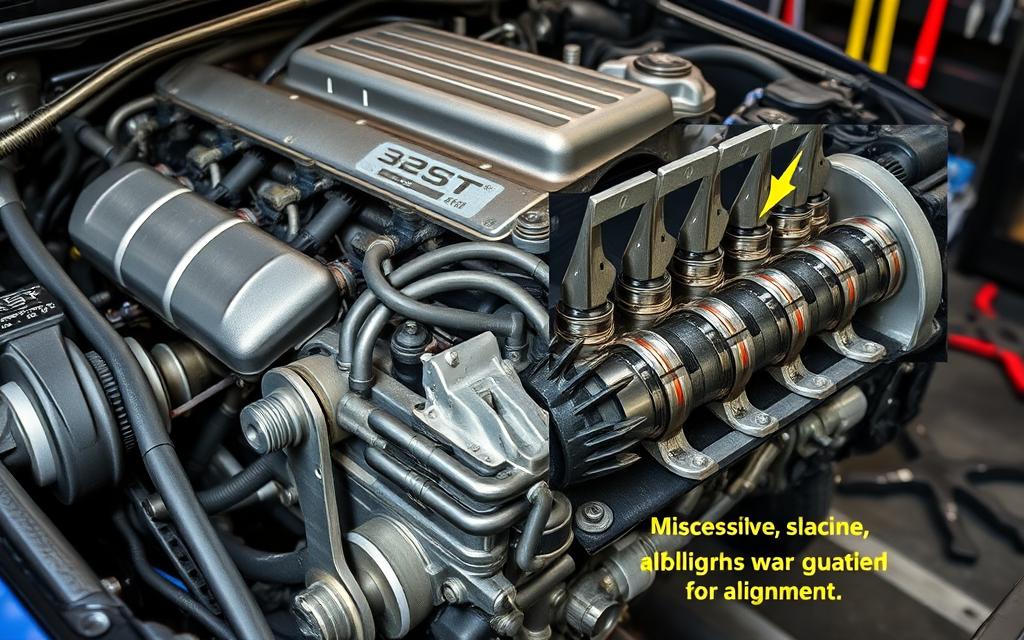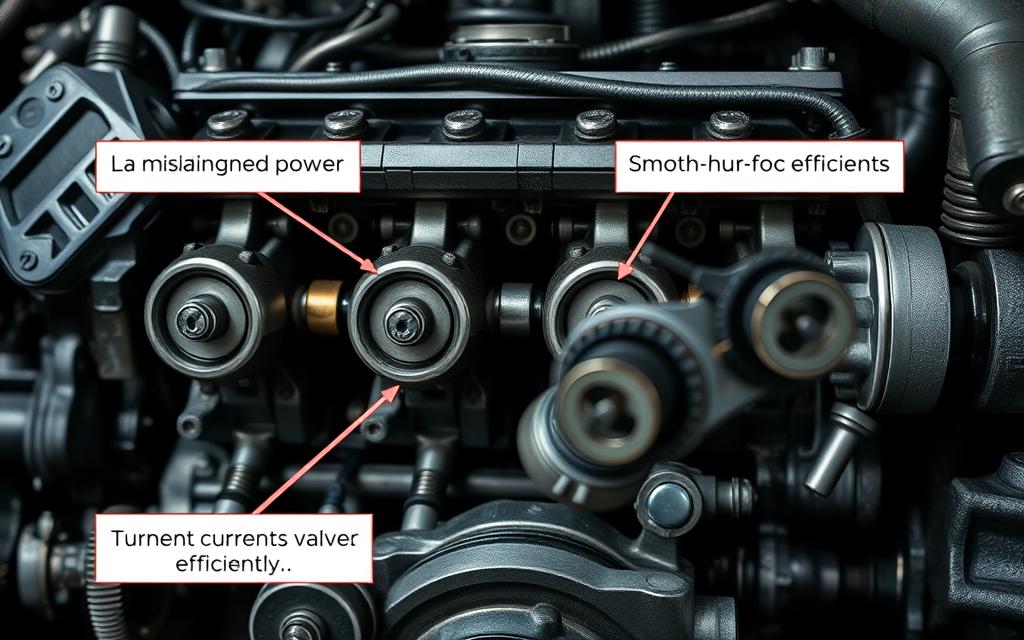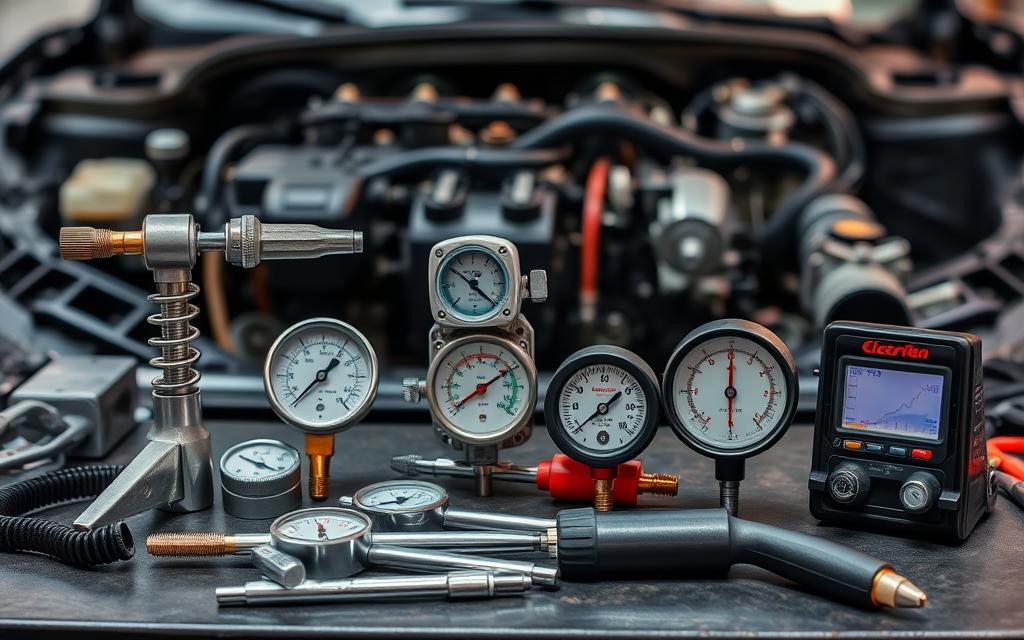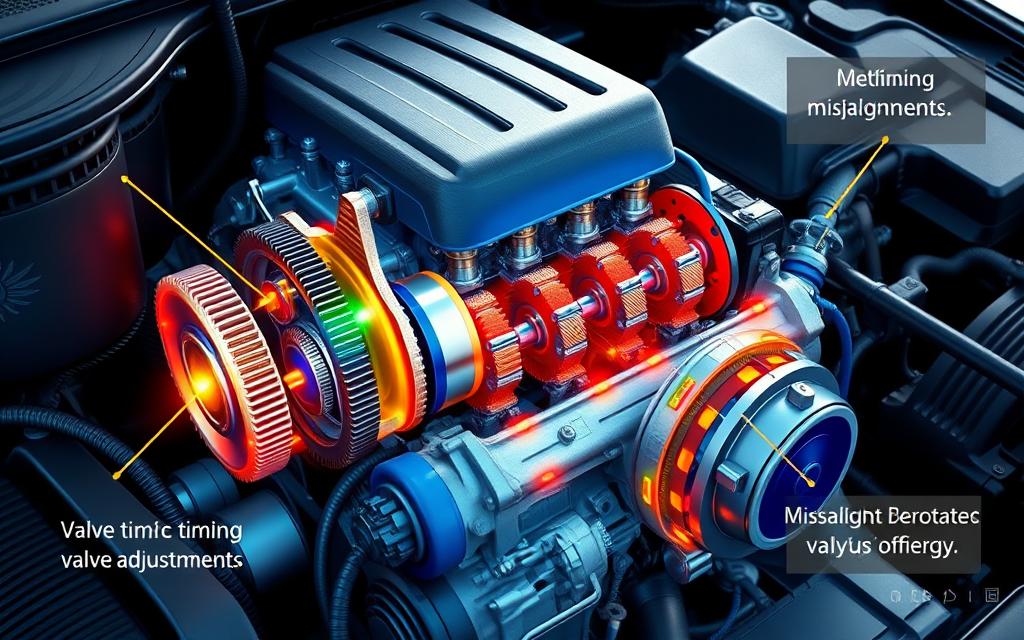In the world of car mechanics, knowing the symptoms of valves out of adjustment is key. When valves are not in the right place, drivers might face problems like engine misfiring, rough idling, and a drop in power. Spotting these signs early can stop bigger issues and keep your car running well for longer. We’ll look at the main signs of valve misalignment and why fixing them quickly is so important.
Key Takeaways
- Spotting symptoms of valves out of adjustment is vital for your engine’s health.
- Common problems include engine misfiring, rough idling, and less power.
- Fixing issues quickly can save you from expensive engine damage.
- Even though modern cars have fewer valve problems, they still need careful checks.
- Getting a pro to check and fix valve issues is the best way to do it right.
Understanding Valve Adjustment and Its Importance
Valve adjustment is key to keeping an engine running well. It ensures that valves open and close correctly, controlling airflow for better combustion. If valves aren’t adjusted right, the engine might not run efficiently or produce more emissions.
It’s important to check valves regularly. Most car makers suggest doing this every 60,000 to 100,000 miles. This helps engines stay in top shape.
Knowing how valves work shows how well an engine operates. The gap between the valve stem and rocker arm needs to be just right, usually around ten to twelve-thousandths of an inch. Getting this just right is crucial to avoid problems.
Many people forget about valve adjustment, but it’s very important. It’s often overlooked in diesel engines, which can lead to lower RPM and more fuel use.
Adjusting valves also need the right tools. You’ll need a set of combination wrenches, a screwdriver, and feeler gauges. After adjusting, the engine will burn fuel better and run smoother.
Common Symptoms of Misaligned Valves

Spotting the signs of misaligned valves can stop engine damage. Adjusting valves is key for good engine performance. When valves don’t align right, you’ll notice some clear signs.
Engine Noise and Ticking Sounds
Unusual engine noises, like ticking, often mean valve problems. These sounds come from the valve train when parts wear out or don’t fit right. As the engine speeds up, the noise gets louder, hinting at lubrication issues or loose parts in the valve train. Attention to these ticking sounds is crucial to avoid bigger hot engine issues.
Poor Engine Performance
Out-of-whack valves hurt your engine’s performance. When valves don’t close right, you might see poor engine performance, like less power and slow acceleration. Bad combustion can also cause excessive exhaust smoke. Fixing valve alignment quickly can get your engine running smoothly again.
Difficulty Starting the Engine
Starting the engine can be tough with misaligned valves, especially in warm weather. Tight valves might not shut properly, making it hard for the engine to start. If not fixed, this can lead to bigger engine problems. Regular checks and correct valve clearance adjustments can help avoid these issues.
| Symptom | Description |
|---|---|
| Engine Noise | Noticeable ticking or popping sounds indicating valve issues |
| Poor Performance | Loss of power and poor acceleration due to misaligned valves |
| Difficulty Starting | Struggles to start the engine, especially when hot |
How Valves Become Out of Adjustment

It’s important to know why valves go out of adjustment. Wear and tear, age, and not enough lubrication can cause problems. Regular checks and adjustments help keep valves working right.
Common Causes of Valve Misalignment
Several things can make valves misalign:
- Age of the Engine: Older engines wear out, causing valves to shift.
- Heat Cycles: Temperature changes can move valves out of place.
- Lack of Lubrication: Without enough oil, valves rub and wear.
- Improper Maintenance: Skipping valve adjustments makes problems worse.
Effects of Wear and Tear on Valves
Valve wear can hurt your engine. It can cause:
- Engine Noises: It sounds like tapping or clicking means valves aren’t working right.
- Reduced Performance: Your engine might not run well if valves aren’t adjusted.
- Increased Emissions: Bad valve alignment can lead to more pollution.
- Potential for Further Damage: Ignoring valve issues can damage them more, needing costly fixes.
Regular valve checks and adjustments, like every 150,000 miles for Mack and Volvo trucks, help a lot. This keeps your engine running smoothly and lasts longer. It shows how important it is to take care of your engine.
| Maintenance Interval | Miles | Kilometres | Months |
|---|---|---|---|
| First Adjustment | 150,000 | 240,000 | 12 |
| Second Adjustment | 300,000 | 500,000 | 24 |
Impact on Engine Efficiency and Performance

Misaligned valves are a big problem for engine efficiency and performance. Cars with valve misalignment often use more fuel and get worse gas mileage. The valves don’t open and close right, so more fuel is used than needed.
Decreased Fuel Economy
Valve misalignment shows up in how much fuel a car uses. When valves don’t work right, the engine can lose up to 20% of its power. This means:
- More trips to the gas station
- Higher costs for fuel
- More time spent waiting in line to fill up
This all adds up to a big drop in fuel economy. The extra fuel used hurts your wallet and the environment.
Loss of Power and Acceleration
Valve misalignment also means less power for the car. Drivers often notice it when they try to speed up. Signs include:
- Harder time going up steep hills
- The throttle is not responding well
- Slower acceleration when merging onto highways
These problems come from engine performance issues. The engine has less power and torque. Even turbocharged cars can’t perform as well with misaligned valves.
In short, ignoring valve adjustments hurts engine efficiency and performance. The result is less power and worse gas mileage. This makes driving harder and costs more money in the long run.
Diagnostic Tools for Valve Issues

Spotting valve problems requires both new technology and old-school methods. Using the right tools makes fixing valve issues faster and better, ensuring your car runs smoothly.
Engine Diagnostic Scanners
Engine diagnostic scanners are key in finding valve troubles. They talk to your car’s computer, pulling out error codes. This helps techs find and fix valve problems that slow down your engine.
Manual Inspection Techniques
But there’s more to finding valve issues than just tech. Manual checks are also important. They include:
- Listening for odd engine sounds, like ticking.
- Watching how the engine performs to spot any oddities.
- Checking valve adjustments to make sure they’re right.
- Doing a full engine check for wear and damage.
Using these methods regularly can catch valve problems early. This keeps your engine in top shape.
When to Consult a Mechanic

Knowing when to see a mechanic is key to keeping your car running well. Spotting signs for mechanic help can stop small problems from getting big. Look out for symptoms that require a pro to check things out.
Signs You Shouldn’t Ignore
Drivers need to watch for signs of serious valve issues. Some important signs include:
- Persistent engine noise that gets worse over time.
- A noticeable loss of power while driving.
- Visible smoke from the engine.
- Frequent misfires, which can mean tight valves.
- The Check Engine light comes on without reason.
Importance of Professional Evaluation
Getting a mechanic’s help is crucial for fixing valve problems quickly. A detailed mechanic inspection can find issues you can’t see. This is important because valve problems can be serious.
For example, only a few cars need valve adjustments. But, if your car has had valve issues before, like some Honda CR-Vs, check it often. This can save you money on big repairs later.
| Symptoms | Recommended Action |
|---|---|
| Engine noise or ticking sounds | Schedule a mechanic inspection |
| Loss of power or acceleration | Consult with a mechanic to evaluate valve issues |
| Visible smoke from the exhaust | Immediate professional assessment is recommended |
| Frequent misfires | Professional evaluation is needed to check valve adjustments |
Acting quickly on these signs can keep your car in top shape. It also helps avoid big engine problems.
Preventative Maintenance for Valves

Keeping valves in good shape is key to a car’s performance and reliability. Regular care helps extend the life of engine parts and keeps things running smoothly. It’s important to have a maintenance plan that includes engine checks and oil changes.
Regular Engine Checks
Regular engine checks are crucial for valve health. They help spot problems early, preventing big damage later. Checking for alignment issues and leaks is part of this.
These checks also look at how pressure and temperature affect valves. Finding leaks early can save a lot of money and keep everyone safe.
Importance of Routine Oil Changes
Oil changes are vital for valve health. They keep the engine well-lubricated, preventing wear and misalignment. This boosts engine performance.
Clean oil also prevents blockages and erosion of valve parts, keeping the engine running efficiently and saving energy. Regular oil changes also help keep valves working smoothly.
| Maintenance Task | Frequency | Benefits |
|---|---|---|
| Routine Engine Checks | Every 5,000 miles | Early detection of issues |
| Routine Oil Changes | Every 3,000 miles | Prevents wear and ensures lubrication |
| Valve Adjustments | Every 150,000 miles (Mack and Volvo) | Extends engine lifespan and performance |
Adjusting Valve Clearances: A Step-By-Step Guide

Adjusting valves is key to keeping your engine running well. It ensures your engine works efficiently and avoids big problems. This guide will show you the tools and steps to adjust valves.
Tools and Materials Needed
Having the right valve adjustment tools is crucial. You’ll need:
- Feeler gauges
- Wrenches
- Replacement shims
- Micrometer (for OHC engines)
- Socket spanner (for turning the crankshaft)
- Safety eyewear
Having these tools for adjusting valves makes the job easier and safer.
Basic Procedure for Adjusting Valves
Here’s how to adjust valves successfully:
- First, wear safety eyewear to protect from debris.
- Then, remove spark plugs, mufflers, and other parts blocking the cylinder head.
- Look at your service manual to know the right order for checking valves, depending on your engine type.
- Put a feeler gauge between the rocker pad and valve stem for pushrod engines. It should fit well but not too tight.
- Use the ‘rule of nine’ for odd vibrations to check valves in the right order.
- If valve faces have uneven seating, lap them to smooth out pits.
- Use a micrometer to measure shims for OHC engines if needed.
- After adjusting, return any parts you removed, replacing seals or gaskets if worn.
Regular checks on valve clearances can help your engine last longer. Some engines have adjustable hydraulic tappets, so they don’t need extra care.
Following these steps helps keep your valves in good shape. It also makes your vehicle run better.
Understanding Valve Timing and Its Role

Valve timing is key to an engine’s performance. It ensures air flows properly into and out of the cylinders, affecting the engine’s efficiency and power. If valve timing is off, it can cause major problems.
How Timing Affects Performance
Timing has a big impact on an engine’s performance. It decides when valves open and close. If timing is wrong, it can cause issues like back pressure and exhaust interference, which can lead to serious engine timing issues.
For example, moving the camshaft forward can help with low-RPM power and a steady idle, but it might hurt high-RPM performance. Moving it back can help at high RPMs but might mess with the idle. Finding the right balance is essential for the engine to work well.
Symptoms of Timing Issues
Spotting symptoms of timing problems early can stop bigger issues. Common valve timing symptoms include:
- Poor acceleration
- Difficulty starting the engine
- Increased emissions
- Engine misfiring
- Unusual engine noises
Knowing these signs helps mechanics fix engine performance issues quickly. This prevents more damage to the engine.
Real-Life Experiences: Drivers Share Their Stories

Many drivers don’t know the importance of valves in their cars. They often think other problems are the cause of issues. This can lead to costly repairs. Drivers share their struggles and lessons about keeping their cars in good shape.
Common Misunderstandings About Valve Issues
Drivers sometimes blame the wrong thing for their car’s problems. They might think engine noise is a sign of age, not a valve issue. A driver’s story shows how ignoring valve problems can lead to big problems.
After 18,000 miles, they found two exhaust valves were too tight. This shows why checking valves regularly is so important.
Lessons Learned from Valve Repairs
Drivers share valuable lessons from their car maintenance experiences. They stress the need for regular valve checks. One driver’s story warns about the dangers of ignoring valve issues.
They had to replace six cam bolts and deal with a stripped head on the seventh. This shows how important it is to catch problems early.
Tables of the driver’s experiences often reveal the importance of proper maintenance practices:
| Mileage at Last Service | Mileage at Current Valve Check | Valve Condition | Parts Required | Time Taken for Repairs |
|---|---|---|---|---|
| 15,000 miles | 33,000 miles | Two exhaust valves are too tight, and one intake valve is nearly too tight | Five valve shims, eight OEM bolts | 5 to 6 weeks |
These stories teach us the value of understanding and fixing valve problems early. Regular maintenance is key to keeping your car running well, and these experiences remind us not to overlook the importance of valve checks.
Conclusion: Addressing Valve Misalignment for Optimal Performance
Understanding valve adjustment is key to your engine’s best performance. Car makers advise regular checks and adjusting valves every 15,000 to 45,000 miles. Some, like Honda, suggest listening to unusual noises to know when adjustments are needed.
Valve clearances get tighter with wear, so it’s crucial to catch problems early. This can prevent bigger issues later.
It is important to know the signs of valve misalignment. Look out for lower efficiency and odd vacuum readings. If your engine acts strangely, check it right away. Fixing valve issues can lower NOx emissions and keep your engine running well.
Putting valve care first helps your engine run better and last longer. It also saves you from expensive repairs. Regular valve checks keep your car running smoothly and safely. Make sure to include them in your car’s maintenance schedule.
FAQ
What are the symptoms of valves out of adjustment?
Why is valve adjustment important for engine performance?
What causes valves to become misaligned?
How can I identify valve issues early on?
When should I consult a mechanic regarding valve issues?
What maintenance practices can help prevent valve misalignment?
What tools do I need to adjust valve clearances?
How does valve timing impact engine performance?
What are common misconceptions about valve issues?
What lessons have drivers learned from valve issues?

Jack Thompson is a writer and seasoned auto mechanic with over 15 years of experience in the automotive industry. Known for his expertise in vehicle mechanics, Jack has a deep understanding of car and truck systems. His skills, honed through years of hands-on experience, have made him a trusted name in the field. Jack is committed to providing valuable insights into car maintenance and repair, helping vehicle owners keep their vehicles in top condition.

